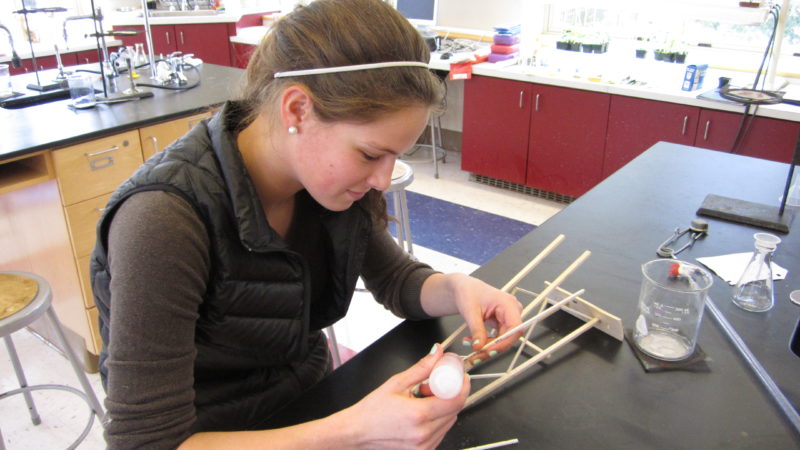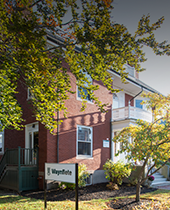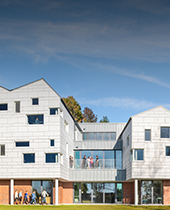On to the Science Olympiad Nationals!
“I’m more nervous right now than I am before a basketball game!” said varsity starter Julianna Harwood as she waited to test the boomilever she had built for the recent State Science Olympiad Tournament at the University of Maine in Orono. Hours beforehand, and well before sunrise, Julianna and twenty-nine other students loaded our bus wearing their green Waynflete Science t-shirts, clutching sleeping bags, and carefully holding boxes containing airplanes, magnetically levitated vehicles, forensics equipment, and more in preparation to compete with students from across the state in science and engineering events.
 Our Physics and Chemistry labs have been buzzing with activity (and the sounds of power equipment) for the past couple of months (demonstrating the Second Law of Thermodynamics: that entropy always increases). Our dedicated young scientists have been coming in to meet with us to learn about simple machines, circuits, and “type la supernovae” (which occur when two stars orbit one another, and one of the stars is a white dwarf while the other can vary from a giant star to an even smaller white dwarf). They have been working through redox reactions, studying rocks and bugs, and burning pistachios for calorimetry measurements. They’ve taken over our lab tables and counter space as they designed, built, and rebuilt their magnetically levitated vehicles, bungee cords, Rube Goldberg devices, “scrambler” vehicles, and elastic-launched gliders. For students in Science Olympiad, the competition begins with an event description – a written page, perhaps two, that describes in intimidating specificity the event in which they will compete. How will the vehicle be propelled? What are its maximum dimensions? How much weight will the balsa boom need to support and how will it be attached to the testing wall? Will the circuitry event include topics such as transformers and inductance? From there, students work with one partner to design, build, test, and redesign an engineering event, or to study and collect materials for a lab or written event.
Our Physics and Chemistry labs have been buzzing with activity (and the sounds of power equipment) for the past couple of months (demonstrating the Second Law of Thermodynamics: that entropy always increases). Our dedicated young scientists have been coming in to meet with us to learn about simple machines, circuits, and “type la supernovae” (which occur when two stars orbit one another, and one of the stars is a white dwarf while the other can vary from a giant star to an even smaller white dwarf). They have been working through redox reactions, studying rocks and bugs, and burning pistachios for calorimetry measurements. They’ve taken over our lab tables and counter space as they designed, built, and rebuilt their magnetically levitated vehicles, bungee cords, Rube Goldberg devices, “scrambler” vehicles, and elastic-launched gliders. For students in Science Olympiad, the competition begins with an event description – a written page, perhaps two, that describes in intimidating specificity the event in which they will compete. How will the vehicle be propelled? What are its maximum dimensions? How much weight will the balsa boom need to support and how will it be attached to the testing wall? Will the circuitry event include topics such as transformers and inductance? From there, students work with one partner to design, build, test, and redesign an engineering event, or to study and collect materials for a lab or written event.
The topics of most of these events are not generally covered in a typical high school curriculum, which means that students need to go above and beyond, learning and researching independently. There are 23 events in all, and students generally compete in three events each, collaborating with their partners throughout the process of preparation. Across the country, over 6700 other schools are preparing for the same 23 events, as tournaments are held in all 50 states. The top finishing team from each state is invited to go on to represent its state in the National Tournament, which is just what Waynflete did last year – traveling to Ohio in May. And they did it again this year, dominating the competition and finishing well ahead of the runner up (Waterville Senior High School). This year’s National Tournament is in Florida on May 17, and the students are excited to deepen their knowledge and improve on their engineering devices in preparation for that tournament (there may also be a bit of swimming).
Waynflete School has been participating in the Science Olympiad competition since its inception in 1985, finishing in the top three overall in all but a few years. It is a lot of work, for both coaches and students, but also tremendously fun, and the payoffs are incredible. For students who are really interested in science, the competition provides a chance to delve deeply into a subject they might not otherwise have the chance to study. For some, with a special interest, it provides a platform to showcase their talent in much the same way that a star athlete can shine at a critical moment in a game.
 Case in point: as the results for the Entomology Event were announced during the closing ceremony of the State Tournament, the team glanced anxiously at our resident insect expert, junior Brandon Woo, and waited expectantly. When the announcement came, “In first place…, Waynflete!” the entire team cheered and hooted as Brandon jubilantly bounced down the stairs of the auditorium to collect his medal, returning to more cheers and high fives from his teammates. And then there is the benefit that the tournament can provide for team members who may not excel in a more traditional classroom (lecture/assessment) setting. Engineering events give these students a chance to explore a topic hands-on, literally. Students learn to design, test, and trouble-shoot problems, learning first hand that nothing ever works the first time you try it, that much can be learned from the mistakes that are made, and developing skills of perseverance and tenacity in the process. Click here for a photo gallery of the state meet.
Case in point: as the results for the Entomology Event were announced during the closing ceremony of the State Tournament, the team glanced anxiously at our resident insect expert, junior Brandon Woo, and waited expectantly. When the announcement came, “In first place…, Waynflete!” the entire team cheered and hooted as Brandon jubilantly bounced down the stairs of the auditorium to collect his medal, returning to more cheers and high fives from his teammates. And then there is the benefit that the tournament can provide for team members who may not excel in a more traditional classroom (lecture/assessment) setting. Engineering events give these students a chance to explore a topic hands-on, literally. Students learn to design, test, and trouble-shoot problems, learning first hand that nothing ever works the first time you try it, that much can be learned from the mistakes that are made, and developing skills of perseverance and tenacity in the process. Click here for a photo gallery of the state meet.
For all students, Science Olympiad offers a chance to collaborate with peers that share a common interest and to discover interests that they never realized before. Often, younger, inexperienced students are paired with older kids who take on a mentoring role and guide them through the processes of preparing for an event. Students learn communication and team-work, skills as important in science as they are in any field. As coaches of Science Olympiad, the ultimate reward is watching as the students who have worked the hardest and put in the most time and energy are rewarded with the gold medal at the end of a very long day. And then, of course, it is also just plain fun. Go Flete! On to Orlando!




